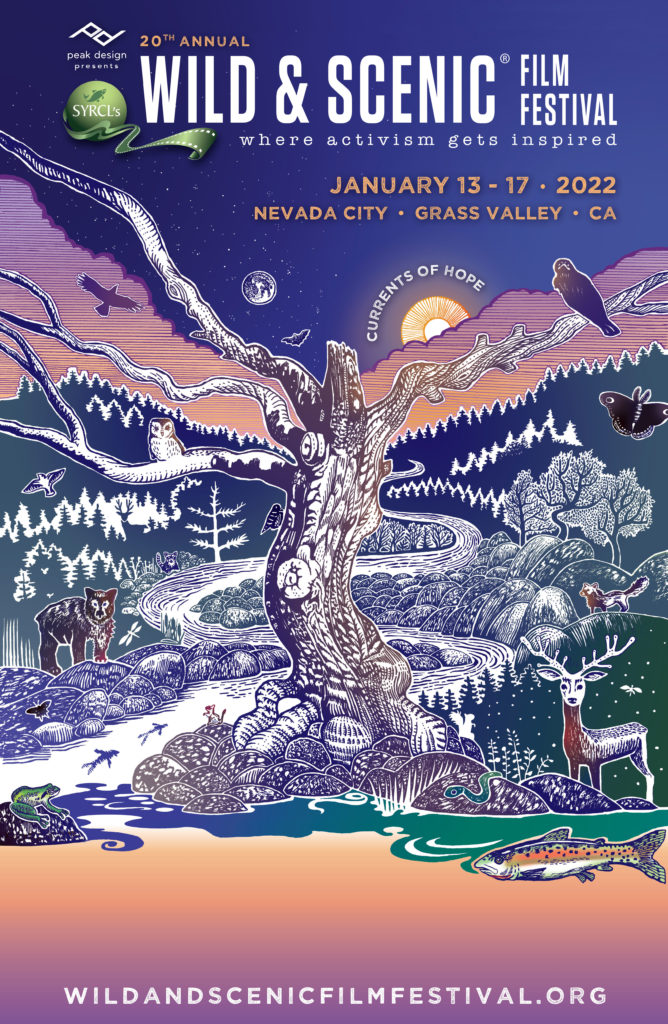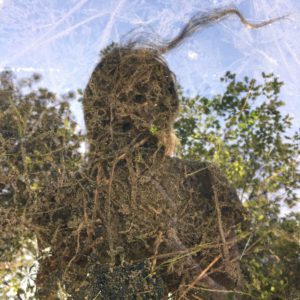Posted on September 13, 2021
Art plays an inextricable role here at the Wild & Scenic Film Festival. We are extremely excited to announce the official artist for WSFF 2022: Maile Claire! Maile is an artist based out of our hometown of Nevada City.
We are so pleased to share the official 2022 poster artwork that she has created for the 20th annual Wild & Scenic Film Festival (January 13-17, 2022). This original piece was chosen as the winner of our poster art contest from a field of wonderfully qualified submissions. We hope you enjoy it as much as we do!

Tell us about yourself. Who is Maile Claire?
Well, I grew up in Honolulu Hawaii, but us a kid I often spent whole summers with extended family up here in the Sierras, so I’ve been returning and returning to this region of the world since I was a small child. I’ve been lucky enough to have many opportunities in this life, to do many different things. I think I’ve probably held over 50 different jobs, many which I don’t care to remember much and never made it onto a resume! In addition to copy girl, housekeeper, administrative assistant, graphic designer, I’ve been an anti-nuclear activist, a homeless rights and dignity advocate, a train-hopping wanderer, a squatter, a home-owning wife and mother of two, a librarian, and artist, newbie gardener, tinkerer and maker of things.
How did you first learn about SYRCL and WSFF?
I learned of SYRCL and the film festival very soon after arriving in Nevada City—seeing those beautiful handmade art posters from both current and past years, almost everywhere. We moved here, as many do, seeking a slower pace, the chance to reset and rebuild a life with more intention and meaning, and with the right relationship to the natural world around us. The film festival itself – seemed to embody, support, and further this yearning.
What excited you about making art for WSFF?
The possibility of putting art into direct service for the earth and the web of life we are all bound up in.
Can you walk us through the artwork you created for the 2022 Wild & Scenic Film Festival? What elements are represented and why?
Once, when I was a kid at a church camp, we were asked to design a poster that represented ‘Peace.’ Without thinking about it much, I drew an old oak tree in a meadow.
“Peace is an old tree, standing forgotten in a meadow,’ said the caption on my poster. I suppose it looked a bit forlorn on the bulletin board next to all the other posters showing people, many people, of all races and creeds, with hands clasped, singing, or dancing, breaking bread together, celebrating. My idea of peace at the time was centered around the non-human world. I suppose it still is. When I started to work on ideas for this poster, Currents of Hope, I realized that old tree was back again, in a local river valley, even older and more gnarled, a tree of life. I started working on adding as many local species surrounding it as I could. It occurred to me that the human should also be included here, as we are also animal, also part of the web of life, also indigenous (that is, if you go back far enough, we all were once).
But I struggled with trying to fit a human form into the image, nothing seemed to work. Then I realized that we’re already included, simply by our gaze. We are the viewer. And the animals, are they only the stuff of our gaze? The animals here mostly seem to be gazing back. They might be asking questions of us. Who are you? Are you kin? Do you recognize or remember us? Do you see that you too are of the land? What will you do next?
Can you tell us about your approach to creating and why the natural world is important to you and your work?
I try to start every day with an early morning walk. When I don’t get the walk in, I can be almost certain I won’t make any art that day, and getting anything else done, from paying a bill to emailing a friend also seems more difficult. I don’t know exactly why this is, but I think it is because the natural world is our true home, the seat of soul and landscape of psyche, in ways that we living in western industrialized cultures are only just beginning to understand. Art is essentially about soul, and soul is always wild.
What do you feel the role of art in activism is?
I’m really not sure. I feel like I’ve been struggling with the proper role and balance of art and activism for quite some time! But if the heart of art is soul, and the nature of the activism is about restoring right relationship between human souls and the soul of the world, well then, there is a kinship there that is foundational.
 Our festival’s tagline is “Where activism gets inspired.” What inspires you?
Our festival’s tagline is “Where activism gets inspired.” What inspires you?
Looking closely, deeply into things and listening with focused attention when wandering in the natural world… this is usually the most incredible and consistent way to perceive miracle. Every leaf— those mottled unexpected colors and branching veins, every acorn, with its scaly or crenulated cap, these small finite things contain the infinite. I believe more of us are waking up to the mystery that lies at the heart of our world and the reason we are all in it. Change is already upon us. There is no stopping the great shifts that are already happening, the warming that has already occurred. But there is the possibility of changing our patterns and working differently with what comes next. The landscape after catastrophic wildfire may never again foster the same set of old growth trees for example, and yet nothing is truly “over” of “finished” in the natural world. Something will grow again and slowly a new ecosystem will emerge. We can choose to be a part of this new emergent world, or we can just keep writing ourselves out of our own story. The choice point is now. That feels very inspiring, doesn’t it?
What does this year’s theme, “Currents of Hope” mean to you, and how is it represented in this piece?
That’s a Cutthroat Lahontan trout in the foreground. They used to be very prevalent in rivers and lakes here, a seasonal food source for Indigenous peoples. Each of these fish could reach upwards of 50-60lbs! They were extinct in our region, effectively by 1940. Currents of Hope is the yearning for a return to this level of health, beauty, interdependence. This sort of natural abundance and profound interconnectedness, which produces fish, sometimes larger than people, is something that could come about again, if only we would work to radically decrease our own oversized human footprint. Currents of hope is the belief that this sort of incredible blossoming and diversity might not be relegated to our past, but could also be our future.
Checkout more from Maile via her website www.junipertreeoflife.com and on her Instagram @maileclaire

